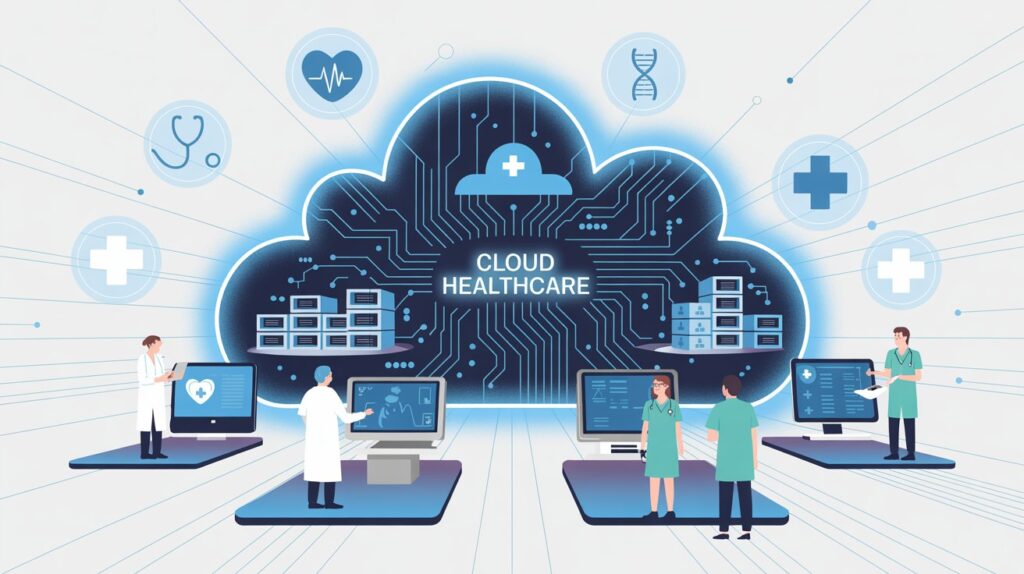Healthcare is a data-intensive industry. From a single patient consultation to global research collaborations, every interaction produces information — often sensitive, complex, and enormous in scale. Medical imaging such as CT or MRI scans can exceed gigabytes per patient; genomic sequencing creates terabytes of data; wearable devices and remote monitoring solutions continuously stream vital signs around the clock. At the same time, electronic health records (EHRs), insurance claims, telehealth visits, and laboratory results all require secure storage and fast retrieval.
Managing this massive volume of data using traditional, on-premises systems is increasingly unsustainable. Hospitals and clinics often face outdated infrastructure, skyrocketing costs, siloed systems, and limited scalability. These limitations not only hinder efficiency but also directly affect patient care and innovation.
This is where Cloud Computing in Healthcare Data Storage is stepping in as a transformative force. By moving to cloud-based storage, healthcare organizations gain access to flexible, scalable infrastructure capable of handling modern healthcare’s demands. Beyond storage, cloud technologies enable secure sharing, advanced analytics, and real-time collaboration that were once impossible at scale.
In this guide, we will examine the drivers of cloud adoption in healthcare, outline its benefits and challenges, and explore emerging trends shaping the future. You will find practical strategies, use cases, and expert insights designed to help healthcare organizations evaluate and adopt cloud solutions effectively.
The Growing Demand for Healthcare Data Storage
The Data Explosion in Healthcare
Healthcare data has been growing at an exponential pace. A decade ago, most hospitals primarily dealt with text-based records and modest imaging files. Today, the ecosystem looks very different:
-
Electronic Health Records (EHRs): Every patient now has a longitudinal medical history recorded digitally, generating structured (diagnosis codes, lab values) and unstructured (doctor’s notes, scanned reports) data.
-
Medical Imaging: Digital imaging modalities like MRI, CT, and PET scans generate files ranging from hundreds of megabytes to gigabytes per scan. Large hospitals generate terabytes of imaging data daily.
-
Genomic Data: Whole genome sequencing produces approximately 200 GB of raw data per patient, fueling precision medicine and research initiatives.
-
IoT and Wearables: Devices like heart monitors, insulin pumps, and fitness trackers continuously stream biometric data to cloud platforms.
-
Telehealth Platforms: Video consultations, digital prescriptions, and remote diagnostics add new layers of data to storage systems.
According to Deloitte, the global healthcare data sphere is expected to reach 2,314 exabytes by 2030, underscoring the urgent need for advanced storage infrastructure.
Limitations of Traditional Systems
While many organizations still rely on in-house data centers, these systems pose challenges:
-
Capacity Bottlenecks: Scaling up requires significant capital investment in servers, storage arrays, and cooling systems.
-
Maintenance Costs: IT staff must continually upgrade and patch infrastructure.
-
Disaster Recovery Risks: On-premises servers are vulnerable to floods, fires, or cyberattacks.
-
Siloed Data: Different departments often operate separate systems, limiting interoperability.
Cloud adoption is accelerating because it solves these pain points by offering elastic, distributed, and secure storage.
What Is Cloud Computing in Healthcare Data Storage?
Cloud computing in healthcare refers to the use of internet-based platforms and services to store, manage, and process medical data. Instead of relying solely on physical servers, healthcare organizations can access cloud-hosted infrastructure on demand.
Deployment Models
-
Public Cloud:
Shared infrastructure hosted by third-party providers such as AWS, Azure, or Google Cloud. Offers high scalability and affordability but requires rigorous compliance oversight. -
Private Cloud:
Dedicated infrastructure operated by a single healthcare organization, either on-premises or hosted by a vendor. Provides maximum control and customization at higher costs. -
Hybrid Cloud:
Combines public and private solutions. For example, sensitive EHR data can remain in a private cloud while imaging analytics runs on a public cloud. -
Community Cloud:
Shared infrastructure designed for multiple organizations with common needs, such as regional hospital networks or public health systems.
Service Models
-
IaaS (Infrastructure as a Service): Virtual servers, storage, and networking resources for healthcare IT teams to build custom solutions.
-
PaaS (Platform as a Service): Platforms for developers to create and deploy healthcare applications, such as telemedicine portals.
-
SaaS (Software as a Service): Ready-to-use cloud-hosted applications, including EHR systems, imaging platforms, or billing solutions.
Benefits of Cloud Computing in Healthcare Data Storage
1. Scalability and Flexibility
Healthcare organizations often experience fluctuating workloads. A sudden outbreak or seasonal patient surge can strain traditional systems. Cloud storage provides on-demand scalability, allowing organizations to expand capacity instantly and reduce it when not needed.
2. Cost Efficiency
Cloud platforms shift expenditure from heavy capital investments (servers, hardware) to operational expenses, where providers pay only for what they use. This model is particularly beneficial for smaller clinics or startups that cannot afford enterprise-grade infrastructure upfront.
3. Interoperability and Collaboration
Cloud platforms enable seamless sharing of patient records among hospitals, specialists, and researchers. For example, a cardiologist in one city can instantly review imaging scans stored by a hospital hundreds of miles away. This improves care coordination and speeds up treatment decisions.
4. Advanced Security
Contrary to outdated perceptions, cloud vendors often provide stronger security than local systems. Features include:
-
End-to-end encryption (at rest and in transit)
-
Multi-factor authentication
-
Intrusion detection and monitoring
-
Automated patching and updates
-
Compliance certifications (HIPAA, GDPR, ISO 27001)
5. Disaster Recovery and Business Continuity
Cloud platforms replicate data across multiple geographic regions. In the event of a cyberattack, natural disaster, or local outage, healthcare organizations can quickly restore access to critical patient records.
6. Driving Innovation Through AI and Analytics
Centralized cloud data makes it possible to run machine learning algorithms that detect disease patterns, predict patient outcomes, and personalize treatments. For example, AI models hosted in the cloud can analyze thousands of chest X-rays in minutes, assisting radiologists in identifying early signs of pneumonia or cancer.
Challenges of Cloud Adoption in Healthcare
Data Security and Privacy
Despite strong vendor safeguards, healthcare remains a top target for cybercriminals. Ransomware attacks on hospitals have increased sharply, and unauthorized access to cloud accounts remains a concern.
Compliance Complexities
Different regions have varying regulations:
-
HIPAA in the United States mandates strict privacy rules for patient data.
-
GDPR in Europe requires explicit patient consent for processing and cross-border data transfer.
-
Local Sovereignty Laws in countries like India or China mandate that patient data remain within national borders.
Ensuring compliance across multiple regions can be challenging for global healthcare organizations.
Vendor Lock-In
Migrating from one cloud provider to another can be expensive and technically complex. Organizations must weigh the risk of long-term dependency on a single vendor.
Integration with Legacy Systems
Many hospitals still use outdated IT infrastructure that is not cloud-ready. Migrating these systems requires extensive planning, investment, and change management.
Skills and Cultural Barriers
Healthcare IT teams may lack the expertise to manage cloud-native systems. Additionally, staff accustomed to traditional workflows may resist change.
Best Practices for Secure Cloud Adoption
-
Perform Comprehensive Risk Assessments before migration.
-
Adopt Zero-Trust Security Models — verify every access request, regardless of origin.
-
Encrypt Data at Multiple Layers, including backups and archives.
-
Implement Fine-Grained Access Controls — restrict access based on role and necessity.
-
Monitor Activity Logs Continuously to detect anomalies.
-
Adopt Hybrid or Multi-Cloud Strategies to balance flexibility and avoid vendor lock-in.
-
Regular Compliance Audits to stay aligned with healthcare regulations.
Real-World Use Cases of Cloud Storage in Healthcare
Telemedicine Platforms
Cloud infrastructure supports the secure storage and transmission of video consultations, digital prescriptions, and health records. Providers like Teladoc rely on cloud scalability to serve millions of patients worldwide.
Medical Imaging Collaboration
Radiologists across continents collaborate by uploading and accessing high-resolution scans in the cloud. This accelerates second opinions and specialist reviews.
Genomics and Biomedical Research
Genomic projects such as the 100,000 Genomes Project rely on cloud storage to host and analyze petabytes of sequencing data.
AI-Powered Diagnostics
Hospitals are deploying AI models in the cloud to assist in cancer detection, cardiovascular risk prediction, and rare disease identification.
Public Health Surveillance
During the COVID-19 pandemic, cloud-based platforms allowed health authorities to track infection rates, manage vaccination data, and share findings globally.
Emerging Trends and Future Outlook
-
Edge Computing: Processes data near the point of collection (e.g., at IoT devices) to reduce latency.
-
Federated Learning: Allows AI models to be trained on distributed datasets without exposing raw patient data.
-
Blockchain Integration: Ensures transparent, tamper-proof audit trails of patient record access.
-
Zero-Trust Architecture: Strengthens identity and access management in healthcare ecosystems.
-
Quantum-Resistant Encryption: Prepares for future security threats from quantum computing.
-
6G and Ultra-Fast Networks: Will enable real-time cloud-based diagnostics and remote surgeries.
The future of Cloud Computing in Healthcare Data Storage is not just about storage but about enabling the next generation of healthcare innovations.
How to Select the Right Cloud Provider
-
Compliance First: Ensure certifications like HIPAA, HITRUST, ISO 27001.
-
Scalability: Assess whether the provider can handle exponential data growth.
-
Security Features: Review encryption, monitoring, and intrusion detection.
-
Reliability: Look for uptime SLAs of 99.9% or higher.
-
Cost Transparency: Avoid hidden fees in bandwidth, storage retrieval, or support.
-
Healthcare Experience: Prefer vendors with proven healthcare deployments.
FAQs
Q1: Is cloud storage safe for sensitive patient data?
Yes, with encryption, role-based access, and regulatory compliance, cloud storage can be safer than local systems.
Q2: What are the biggest barriers to adoption?
Security concerns, regulatory compliance, and integration with legacy IT remain the primary challenges.
Q3: Can small clinics benefit from cloud adoption?
Absolutely. Smaller providers gain access to enterprise-level infrastructure without the upfront costs.
Q4: Which vendors dominate the healthcare cloud market?
Amazon Web Services (AWS), Microsoft Azure, Google Cloud, IBM Cloud, and Oracle, along with healthcare-specific providers like Dell and GE Healthcare.
Q5: How does cloud computing enable innovation?
By centralizing massive datasets, it supports AI-driven diagnostics, precision medicine, and collaborative research worldwide.
Conclusion
The healthcare industry is evolving rapidly, driven by rising data demands, patient expectations, and technological innovation. Traditional systems are no longer adequate for storing, protecting, and leveraging the petabytes of information generated daily. Cloud Computing in Healthcare Data Storage has emerged as a game-changing solution, providing scalability, cost savings, interoperability, and enhanced security.
Yet, cloud adoption is not without challenges. Issues such as regulatory compliance, data sovereignty, and integration hurdles require careful planning and execution. The organizations that succeed will be those that approach cloud migration strategically, with strong governance, skilled teams, and the right vendor partnerships.
Ultimately, cloud computing is not just about storing medical records more efficiently. It is about enabling better healthcare — faster diagnoses, more personalized treatments, global collaboration, and stronger resilience against future crises. For healthcare providers, embracing the cloud today means laying the foundation for a more connected, secure, and innovative future.













